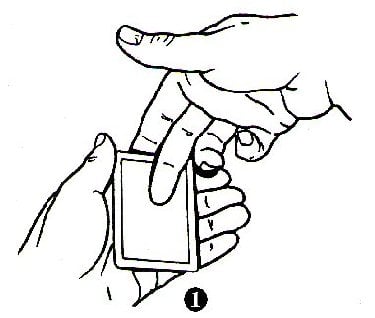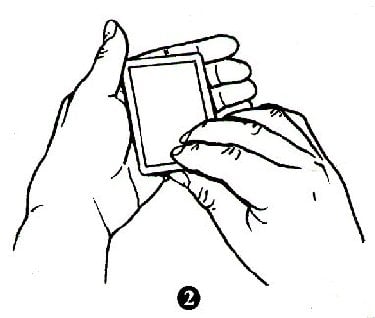|
Pirouette is a ballet term that means “a whirling around on one foot or the point of the toe.” It has nothing to do with the trick … maybe … but I liked the name! Probably what made me think of a Pirouette was the Paddle Move, the basic move required for this routine. Many versions of this Francis Carlisle move have been born (a notable one being the Nick Trost variation) but in this routine I make use of the Karl Fulves variation, a nice move called the Turnabout.
Effect
Two cards are selected and left on the table. The performer shows four Jokers on both sides. Two of these Jokers change the color of their backs and the other two become duplicates of the two selected cards!
Requirements
A deck of cards, say blue backed. You also need two red backed Jokers and a duplicate of two cards with the blue backs (say the 10 of Clubs and the 3 of Hearts).
Set-Up
Keep the 10 of Clubs and the 3 of Hearts in the deck in a position ready to be forced. I keep them on top of the face down deck, either one on top. The other four cards are in this order from top to bottom: Face down 10 of Clubs, face up Joker, face down 3 of Hearts and face up Joker. (It doesn’t matter whether the 10 of Clubs or the 3 of Hearts is first; they can be in any order.) These four cards are kept as a separate packet.
Performance
Force the 10 of Clubs and the 3 of Hearts from the deck to two spectators and leave the two cards face up on the table. (I am sure you have your favorite method of forcing two cards, but I’ll give you a simple one at the end of the trick.)
Take out the Joker packet and fan the cards showing two face up Jokers interlaced with two face down cards. Square the cards and keep them in the left hand dealing position. You are now going to perform the Karl Fulves’ Turnabout which is a great move to apparently show both sides of a packet of cards while really, you are showing the same side twice. Grip the packet as in figure 1, right middle finger on top, right forefinger below. Turn the packet over, end for end, to the position shown in figure 2. As the packet turns, it also turns side for side and the same side of the packet is upward at the end of the turn. Fan the cards again to apparently show the other side of the cards (two more Jokers and two face down cards) and then square the packet.
Ask a spectator to point to two Jokers (the face down Jokers or the ones face up). No matter which are the Jokers pointed at, leave the two face down cards on the table; i.e., if the spectator points to the two face down cards you may say, “O.K. we’ll use these because the other two Jokers are really strange.” Turn them over and show they have a red back.
If the spectator points to the face up Jokers you may say, “It’s funny that you have chosen these two because they are really strange.” Turn them over and show that their backs are red.
Pick up the other two (supposed) Jokers and with them, touch the two selected cards (face to face) and then turn the Jokers over to show the duplicates of the selected cards for the finale.
Notes
Of course, the choice of which Jokers to use at the end of the routine is the Magician’s Choice and it is optional. You can proceed with the revelations without having the spectator select which Jokers to use.
A simple force could be the following: Have one of the two cards you want to force on top of the deck and one on the bottom. Table the deck and have a spectator cut the top half which is then tabled face down next to the bottom half. This bottom half is then taken and placed on top of the other, but crosswise. Show the packet of Jokers to lose a bit of time and then lift up the top half showing the bottom card of this portion and the top card of the tabled half. Easy and effective (this is called the Criss Cross Force).
|




